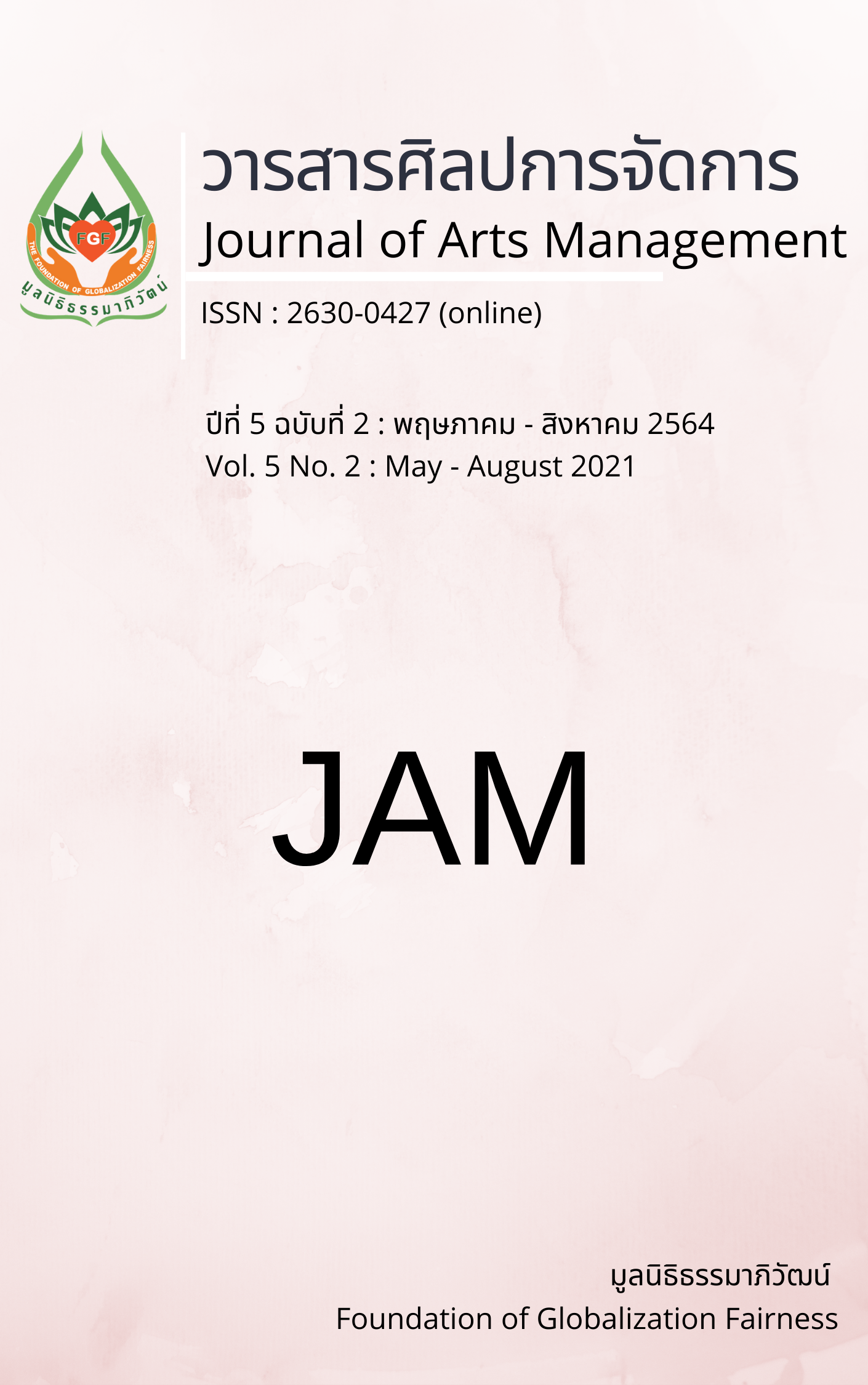The Influencing of Causal Factors Repurchasing Intention Cosmetics on Facebook Fanpage of Consumers in Bangkok and Its Vicinity
Main Article Content
Abstract
This article aimed to 1) develop and validate the consistency a causal factor repurchasing intention cosmetics on Facebook Fanpage of consumers in Bangkok and its vicinity; 2) study about the influencing of causal factors repurchasing intention cosmetics on Facebook Fanpage of consumers in Bangkok and its vicinity. The sample group consisted of 215 people who have repurchasing cosmetics on Facebook Fanpage. The tools used in the research were online questionnaires. The statistics used in data analysis were frequency, percentage, and structural equation model.
The results of this research were causal relationships to develop consisting of 4 components were 1) Satisfaction 2) Trust 3) Loyalty and 4) Repurchase Intention and the model was consistent with the empirical data to a great extent. The statistic showed the Chi-square statistics goodness fit test (2) = 157.78, degrees of freedom (df) = 151, CMIN / DF = 1.04, GFI = 0.93, AGFI = 0.90, SRMR = 0.03, RMSEA = 0.01. The final was predictive coefficient of 0.97, indicating that the variables in the model can explain the variance of the repurchase intention of cosmetics on Facebook Fanpage by 97 percent. It was found that the consumer attitudes were the most influence on repurchase intention of cosmetics on Facebook Fanpage of the consumers in Bangkok and its vicinity. The results of this research were useful for entrepreneurs, owner of cosmetics on Facebook Fanpage businesses were utilized to the marketing plan and create marketing strategies that were suitable for consumers. Resulting in repurchasing intention to the online course in the future.
Article Details
Views and opinions appearing in articles in the Journal of Arts of Management It is the responsibility of the author of the article. and does not constitute the view and responsibility of the editorial team I agree that the article is copyright of the Arts and Management Journal.
References
กริช แรงสูงเนิน. (2554). การวิเคราะห์ปัจจัยด้วย SPSS และ AMOS เพื่อการวิจัย. กรุงเทพฯ: ซีเอ็ดยูเคชั่น.
ฉัตรสุดา กลิ่นรอด และ สมชาย เล็กเจริญ. (2563). โมเดลความสัมพันธ์เชิงสาเหตุความพึงพอใจในการใช้บริการตรวจสภาพรถมือสองผ่านเพจเฟซบุ๊กของผู้บริโภคในเขตกรุงเทพมหานครและปริมณฑล. วารสารศิลปการจัดการ, 4(2), 429-443.
ฉันธะ จันทะเสนา. (2562). ตัวแปรที่มาก่อนของการตั้งใจซื้อซ้ำในพาณิชย์อิเล็กทรอนิกส์ไทย. วารสารการพัฒนาทรัพยากรมนุษย์และองค์การ, 11(2), 34-51.
ชไมพร กาญจนกิจสกุล. (2555). ระเบียบวิธีวิจัยทางสังคมศาสตร์. ตาก: โพรเจ็คท์ไฟฟ์-โฟว์.
ธีรพันธ์ โล่ทองคำ. (2550). กลยุทธ์สื่อสารการตลาดแบบครบวงจร. กรุงเทพฯ: ทิปปิ้ง พอยท์.
นงลักษณ์ วิรัชชัย. (2542). โมเดลลิสเรล: สถิติวิเคราะห์สำหรับการวิจัย. (พิมพ์ครั้งที่ 3). กรุงเทพฯ: โรงพิมพ์แห่งจุฬาลงกรณ์มหาวิทยาลัย.
นพดล สายคติกรณ์. (2558). การพัฒนาเทคโนโลยีสารสนเทศทางการตลาดสมัยใหม่เพื่อส่งเสริมผลิตภัณฑ์ชุมชนและท้องถิ่น
ใน อ. หัวหิน จ.ประจวบศีรีขันธ์. Veridian E-Journal Silpakorn University: Humanities, Social Sciences, and Arts, 6(1), 648-660.
ปิยะวัน เพชรหมี. (2563). ผู้ประกอบการเพื่อสังคมกับความสามารถในการแข่งขันมุ่งเน้นผลิตภัณฑ์สินค้าสร้างสรรค์เพื่อการท่องเที่ยวของจังหวัดเพชรบูรณ์. วารสารสหวิทยาการมนุษยศาสตร์และสังคมศาสตร์, 3(3), 367-379.
พิริยะ เงินศรีสุข. (2563). การสื่อสารการตลาดดิจิทัล สำหรับนักท่องเที่ยวกลุ่มเจนเนอเรชั่น ซี. วารสารสหวิทยาการมนุษยศาสตร์และสังคมศาสตร์, 3(2), 298-310.
วรรณเทพ จันทร์จรูญจิต และ สมชาย เล็กเจริญ. (2563). รูปแบบความสัมพันธ์เชิงสาเหตุความภักดีที่มีต่อตราสินค้ายูนิโคล่ผ่านสื่อสังคมออนไลน์ของผู้บริโภคในเขตกรุงเทพมหานครและปริมณฑล. วารสารปัญญาภิวัฒน์, 12(3), 120–133.
ศิริวรรณ พันธุ. (2562). ปัจจัยที่ส่งผลต่อการตั้งใจซื้อซ้ำผลิตภัณฑ์สมุนไพรเสริมอาหารผ่านออนไลน์. วารสารวิทยาการจัดการปริทัศน์, 21(1), 63-71.
สุทธิดา บัวศรี และ สมชาย เล็กเจริญ. (2563). โมเดลความสัมพันธ์เชิงสาเหตุความตั้งใจในการซื้อซ้ำสินค้าผ่านแอปพลิเคชันของผู้บริโภคในเขตกรุงเทพมหานครและปริมณฑล. วารสาร มจร พุทธปัญญาปริทรรศน์, 5(2), 82-93.
Rainmaker. (2563). อัปเดต Digital Stat ปี 2020 ของ Facebook. สืบค้นเมื่อ 10 มกราคม 2564, จาก https://www.rainmaker.in.th/digital-stat-2020-facebook
Chinomona, R., & Sandada, M. (2013). Customer Satisfaction, Trust and Loyalty as Predictors of Customer Intention to Re-Purchase South African Retailing Industry. Mediterranean Journal of Social Sciences, 4(14), 437-446.
Hair, J., William C. B., Barry J. B., & Rolph E. A. (2010). Multivariate Data Analysis. (7th ed.). New Jersey: Prentice Hall.
Hoelter, J. W. (1983). The Analysis of Covariance Structures: Goodness-Of-Fit Indices. Sociological Methods and Research, 11(1), 325-344.
Keller, K. L. (2003). Strategic Brand Management. New Jersey: Upper Saddle River.
Kotler, P. (2009). Marketing Management Millennium Edition. New Jersey: Prentice Hall.
Powers, T., Advincula, D., Austin, M., Graiko, S., & Snyder, J. (2012). Digital and Social Media in the Purchase Decision Process. Journal of Advertising Research, 52(4), 479-489.


